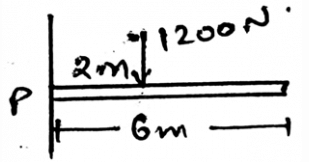Test: Conditions For A Rigid-Body Equilibrium - Mechanical Engineering MCQ
30 Questions MCQ Test - Test: Conditions For A Rigid-Body Equilibrium
The main condition for the rigid body is that the distance between various particles of the body does change.
The shown here has a mass of 100kg. What is missing here in the diagram?

What does the Newton’s third law states?
Determine the horizontal components of the reaction on the beam caused by the pin at P. The force 60N is multiplied by 10 and then is applied.
For equilibrium the net force acting on the body is zero.
For equilibrium the net moment acting on the body by various forces is zero.
Determine the vertical components of the reaction on the beam caused by the pin at Q. The force 60N is multiplied by 10 and then is applied.

The net moment of the body is zero that means the distance between the force and the rotational axis is zero.
Determine the horizontal components of the reaction on the beam caused by the roller at P.
The net force of the body is zero that means the force are not being applied to the body at all and hence the body is in equilibrium.
Determine the vertical components of the reaction on the beam caused by the roller at P.
For the conditions of the equilibrium of the body, i.e. the rigid body only the external forces defines the equilibrium. Because the internal forces cancels out so not to be considered.
Which of the following needs to zero for the perfect equilibrium?
Determine the vertical components of the reaction on the beam caused by the pin at P. The force 60N is multiplied by 10 and then is applied.
Free body diagrams doesn’t play any role in making the calculations on the conditions of the equilibrium of the body.
The net forces of acting on the body needs to be zero. This is also applicable for the simply supported beams. This means that the support reaction are also counted in making the net force zero.
Determine the horizontal components of the reaction on the beam caused by the pin at Q.
If the body is in equilibrium, but it having a rotational curled ray shown in the free body diagram then:
If five forces of equal magnitude act concurrently on a particle and are equally spaced by 72° around a point, then:
What does the Newton’s second law states?
Determine the vertical components of the reaction on the beam caused by the pin at Q.
Determine the vertical components of the reaction on the beam caused by the pin at Q. The force 60N is multiplied by 10 and then is applied.
For the conditions of the equilibrium of the body, i.e. the rigid body only the external forces defines the equilibrium. And the support reactions only cancels out the rotation part of the body.
Cantilever beams are always in equilibrium, whether you form the equilibrium equations or not.
Determine the horizontal components of the reaction on the beam caused by the pin at Q.
Determine the vertical components of the reaction on the beam caused by the pin at Q. The force 60N is multiplied by 10 and then is applied.
For the conditions of the equilibrium of the body, i.e. the rigid body only the external forces defines the equilibrium. And the support reactions only adds the rotation part of the body.















